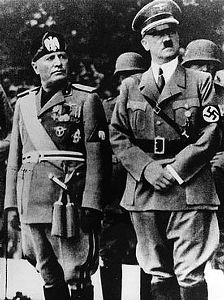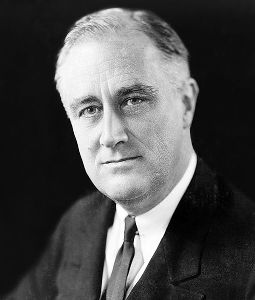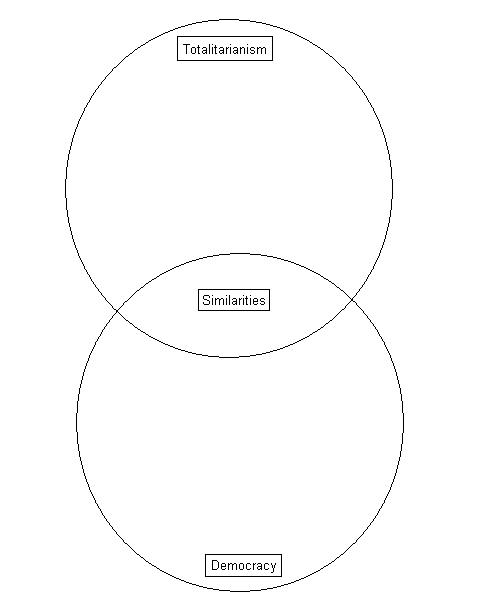LESSON PLAN:
Hitler’s Fatal Gamble: Comparing Totalitarianism and Democracy
When Adolf Hitler set in motion World War II, he was gambling that his Nazi government and society could produce soldiers and citizens tougher than those of Great Britain, France and the United States. Totalitarian fanaticism and discipline, he thought, would always conquer democratic liberalism and softness. He was wrong. What was it about democracy that allowed the Allies to win the war?
Objective:
Students gain an understanding of similarities and differences between totalitarianism and democracy as it pertains to WWII.
Grade Level: 9-12
Standards:
History Thinking Standard 3—the student compares and contrasts differing sets of ideas, values, personalities, behaviors, and institutions by identifying likenesses and differences.
Content Era 8 (1929-1945) Standard 3A—the student understands the international background of World War II. Standard 3B—the student understands World War II and how the Allies prevailed.
Time Requirement: One class to two class periods (depending on how time is organized).
Download a printable pdf version of this lesson plan
Directions:
1. Write this quotation on the board and discuss: "Many forms of government have been tried, and will be tried in this world of sin and woe. No one pretends that democracy is perfect or all wise. Indeed, it has been said that democracy is the worst form of government except all those other forms that have been tried from time to time.” –Winston Churchill, 1947
2. Distribute the handout describing totalitarianism and democracy. Read aloud. Lead the class in a brainstorming activity of possible characteristics of totalitarianism and democracy. Ask a student to record these on the chalkboard. You may also pass out copies of the vocabulary sheet to students or use them as a teacher resource.
3. Lead a class discussion regarding what life might be like living in Germany under a totalitarian regime. Contrast this discussion with life in the United States in a democracy.
4. Divide the students into pairs. Distribute the Venn diagram template and explain how it functions. Each group will use the Venn diagram to list the similarities and differences of these two political systems. Assign one to record the information and one to present its findings. When completed each group should present its findings to the class.
5. Hold a class discussion: Which system of government is strongest and why? The student worksheet may be completed in class after the discussion or may be given as homework.
Assessment:
Components for assessment include the completed Venn diagram, oral presentation, and discussion.
Enrichment:
Have students create Venn diagrams comparing and contrasting candidates and their positions for an upcoming election.
What is Totalitarianism?

Mussolini and Hitler
Totalitarianism is a form of government that exercises complete political, economic, social, cultural, and spiritual control over its subjects. A charismatic leader, or dictator, who controls the one allowable political party, usually heads it. This form of rule requires complete subordination of the individual to advance the interests of the state. People are made dependent on the wishes and whims of the political party and its leader. The government of Nazi Germany was an example of a Fascist, totalitarian state. Its ideology and practice included a racial theory that denigrated, persecuted, and murdered “non-Aryans,” particularly Jews. It also advocated extreme nationalism that called for the unification of all German-speaking peoples and required the centralization of decision-making by, and loyalty to, a single, all-powerful leader. The use of paramilitary secret organizations to stifle dissent and terrorize opposition ensured complete compliance. Information and ideas were effectively disseminated through government-controlled propaganda campaigns using radio, the press, and education at all levels. Writers, speakers, actors, composers, and poets were licensed and controlled by the government. The centrally controlled economy enabled the government to control its workers, making them dependent on the government. All workers were required to possess a work permit, which could be withdrawn for offenses such as objecting to poor working conditions. In a totalitarian dictatorship there is no legal means of effecting a change of government. Civil rights and human rights are not guaranteed.
What is Democracy?

President Roosevelt
Democracy is a system of government in which ultimate political authority is vested in the people. Representatives elected by popular suffrage (voting) exercise the supreme authority. In democracies such as the United States, both the executive head of government (president) and the legislature (Senate and House of Representatives) are elected. The powers of government are based on the consent of the governed. Groups or institutions typically exercise the democratic theory in a complex system of interactions that involve compromises and bargaining in the decision process. The major features of a modern democracy include government only by the consent of the governed, individual freedom guaranteed by a constitution, equality before the law, which maintains that all persons are created equal with minority rights protected, universal suffrage, and education for all. Citizens are free to join any political party, union, or other legal group if they choose. Elected representatives may be supplanted by the electorate according to the legal procedures of recall and referendum, and they are, at least in principle, responsible to the electorate. Citizens retain the right to alter or abolish a government that becomes destructive and form a new government. There are no paramilitary organizations sanctioned by the government to suppress those citizens who voice opposition to the government. The cornerstones of democracy are freedom of speech, freedom of assembly, freedom of the press, and freedom of religion.
Vocabulary
Civil liberties: The right of the people to be free from unreasonable interference, especially from the government.
Civil rights: The right to participate in government equally with other citizens and to receive equitable treatment from the institutions of government and society.
Communism: A social, political, and economic system characterized by the revolutionary struggle to create a society which has an absence of classes, the common ownership of the means of production and subsistence, and centralized governmental control over the economy and society. The Soviet Union was a communist country.
Democracy: A political system in which the government rules by consent of the governed.
Dictator: A ruler having absolute authority and supreme jurisdiction over the government of a state, especially one whom is considered tyrannical or oppressive.
Elitism: Philosophy that a narrow clique of the "best" or "most skilled" members of a given social group should have the power.
Equality: The impartiality of law and government in treating all citizens by the same rules and standards.
Fascism: A totalitarian philosophy or system of government that advocates or exercises a dictatorship of the extreme right wing of the political spectrum, typically through the merging of state and business leadership, together with an ideology of belligerent nationalism and racism. Nazi Germany was a fascist state.
Federalism: A system of dividing powers territorially, so that there are strong constituent units and a strong central authority, each with powers that the other cannot abolish. The separation of powers between the federal government and state governments in the United States is an example of federalism.
Government: Human institutions designed to afford protection from external and internal threats, and, at best, to establish policies that will provide the most favorable conditions under which citizens may live.
Ideology: The body of ideas reflecting the social needs and aspirations of an individual, group, class, or culture.
Liberalism: A political philosophy advocating individual freedom, democratic forms of government, gradual reform in political and social institutions.
Liberty: Right of individuals to act as they choose.
Nationalism: The doctrine that national interests are more important than individual or international considerations; often favors an aggressive, threatening, warlike foreign policy.
Nazism: The ideology and policies of Adolf Hitler and his National Socialist German Worker's Party from 1921 to 1945; a totalitarian Fascist-like system which is strongly anti-Semitic, anti-communist, anti-democratic.
Pluralism: A theory of politics viewing democracy as dominated by competition among different organized interest groups.
Popular sovereignty: The doctrine that the power to make governmental decisions and changes resides in the people.
Propaganda: The systematic, widespread dissemination or promotion of particular ideas, doctrines, or practices to further one’s own cause or to damage an opposing one.
Referendum: A device by which acts passed by a legislature are referred to the people for acceptance or rejection at the polls.
Republic: A form of state based on the concept that sovereignty resides in the people, who delegate the power to rule in their behalf to elected representatives and officials.
Socialism: A social, political, and economic system in which the major industries are nationalized, but which comes to power through the consent of the governed.
Totalitarianism: A form of government in which all societal resources are monopolized by the state in an effort to penetrate and control all aspects of public and private life, through the state's use of propaganda, terror, and technology; the individual exists to serve the state.
Venn Diagram: Totalitarianism vs. Democracy

Discussion Questions
Directions: Answer the following questions after the class discussion. You should use your own knowledge of the topic along with material from the lesson.
1. For both political systems, who makes and carries out the rules? How are these rules created?
2. What does each group believe in?
3. How do these beliefs impact its citizens?
4. What happens to citizens of each government if they disagree with the group in power?
5. How do totalitarian governments threaten world stability?
6. How does this lesson add to your understanding of United States involvement in WWII?
7. Can you think of any current totalitarian/democratic conflicts? What are the different ways this conflict could play out?
Download a printable pdf version of this lesson plan
TAKE ACTION:


EDUCATION PROJECTS:
Student Travel – WWII Educational Tours
High school and college students, learn the leadership principles that helped win WWII on a trip to France or during a weeklong residential program in New Orleans. College credit is available, and space is limited.
See You Next Year! HS Yearbooks from WWII
Collected from across the United States, the words and pictures of these yearbooks present a new opportunity to experience the many challenges, setbacks and triumphs of the war through the eyes of America’s youth.
The Victory Gardens of WWII
Visit the Classroom Victory Garden Project website to learn about food production during WWII, find lesson plans and activities for elementary students, get tips for starting your own garden and try out simple Victory Garden recipes!
The Science and Technology of WWII
Visit our new interactive website to learn about wartime technical and scientific advances that forever changed our world. Incorporates STEM principles to use in the classroom.
Kids Corner: Fun and Games!
Make your own propaganda posters, test your memory, solve puzzles and more! Learn about World War II and have fun at the same time.



